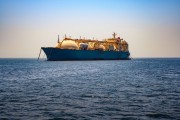Imagine that Canada's Minister of Defence got up one day and announced that all our military decisions will be made jointly with the United States from now on. Canada and the U.S. would use the same tactics and embrace the same goals.
Hard to picture, perhaps. But it's more or less the approach that Environment Minister Jim Prentice laid out in a speech in Toronto last month.
According to the speech, Canada will aim for a "common cap and trade system" with the U.S., "a shared target" for cleaner electricity, "common fuel efficiency standards," and a common target for biofuels.
Those elements alone would cover 70% or more of Canada's greenhouse gas pollution, but the minister went further: he also proposed that Canada and the U.S. take on a collective, bi-national emissions target in the next global climate treaty.
To say the least, this approach puts a lot of faith in President Obama. In addition to solving the economic crisis and finding peace in the Middle East, he's now entrusted with leading Canada's global warming policy.
In some ways, he's extremely qualified to fill that vacancy. President Obama has already shown signs of being the first national leader in North America to truly make climate change a priority.
Take his economic "recovery and re-investment" plan. Far from shying away from climate action in tough times, Obama put it front and centre. His proposal includes over $C80 billion for green investments like renewable energy, retrofits to make homes more efficient, and public transit.
In contrast, Canada's budget included about $1.7 billion over two years for green energy initiatives, five times less than the U.S. will spend on a per capita basis.
Obama campaigned on an economy-wide cap and trade system for greenhouse gases, including a commitment to sell 100% of the system's "pollution permits" to industry instead of handing them out for free.
Last March, the Canadian government proposed an emissions trading system that failed to set a cap on pollution at all, thanks to its reliance on "intensity" targets.
At the level of rhetoric, the contrast between the two governments is even more glaring.
Announcing a key step toward the more stringent tailpipe emissions standards proposed by California, Obama stated: "If we take action, we can create new industries and revive old ones, we can open new factories and power new farms, we can lower costs and revive our economy."
North of the border, the idea that climate action is good for the economy simply has not penetrated Canada's government. Instead, our Environment Minister used his first speech to promise that he "will not - and let me be clear on this - aggravate an already weakening economy in the name of environmental progress."
For the past eight years, Canada's feeble efforts to combat global warming could still be favourably compared to the American record of outright inaction. But George Bush's climate policy is long gone - and now it's Canada that is slipping into the role of North America's climate laggard.
Of course, some degree of cooperation with the U.S. is common sense. Greenhouse gases don't respect borders, and Canada's economy is highly integrated with our southern neighbour's. But there are some very real downsides to merely "waiting for Barack".
First, the 2020 emissions target Obama has supported to date falls far short of the reduction that scientists say is needed to have a chance of avoiding dangerous global warming. (Canada's own 2020 target is marginally better than Obama's, but still far from the benchmark set by the science.) Both countries have urgent work to do in strengthening those targets to accept their fair share of the global effort.
The U.S. is only now starting serious work on a cap and trade system, which means it could take until 2012 to have a system up and running. Despite the weaknesses of the government's proposal, Canada does have an advantage here, as our emissions trading system was slated to take effect in January 2010.
That two-year gap gives Canada a chance to lead by scrapping the old approach in favour of a strong, effective system - starting in 2010. As a policy-maker with a success story to tell, Canada would enjoy far more influence than if we sit on the sidelines waiting for instructions from Washington.
And unless Canada moves quickly to a stronger approach, there is good reason to worry about the role our country could play.
Canada has a long and sorry history of designing climate policies that favour the companies operating in Alberta's oilsands, and the current government has been no exception.
If the government decides that it's in our national interest to defend our "dirty oil," Canada's role in climate policy negotiations with the U.S. could amount to little more than looking for concessions.
So, no matter how impressed we may be with President Obama, Canada needs to consider an even better source of inspiration for its climate policies - the science.
Climate scientists have provided clear analysis of the level of emission reductions we need to make. Economists have shown that the costs of serious action are modest, and are far outweighed by the costs of unchecked climate change.
Canadians agree. A poll from November 2008 found that 78% of Canadians want Canada's climate targets to be based on the advice of scientists, even if meeting these targets means some cost.
So, here's some simple advice for Stephen Harper as he prepares to meet Barack Obama: now is the time for Canadian climate leadership. A bold vision will impress the U.S. president - and merely following behind the U.S. will surely fail to impress Canadians.





